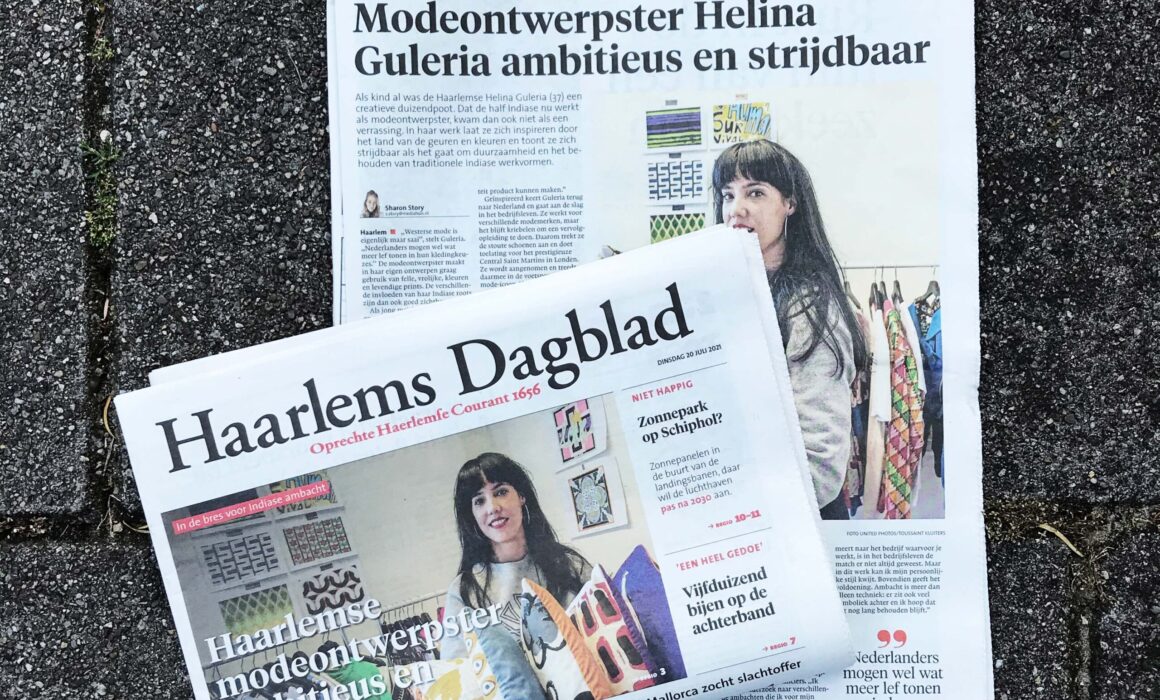Haarlems Dagblad
In the breach for the preservation of traditional Indian working methods
Fashion designer Helina Guleria ambitious and combative
As a child, Helina Guleria (37) from Haarlem was a creative centipede. It was therefore no surprise that the half Indian now works as a fashion designer. In her work she is inspired by the land of scents and colors and shows herself to be combative when it comes to sustainability and the preservation of traditional Indian working methods.
“Western fashion is boring”, says Guleria, “The Dutch should be a bit more daring in their clothing choices.” The fashion designer likes to use bright, cheerful colors and lively prints in her own designs. The different influences of her Indian roots are clearly visible.
As a young girl, Guleria was fond of drawing. At HAVO she came into contact with textile working methods, after which it soon became clear that she wanted to follow a fashion education. “I really liked the combination of textiles and drawing. Designs really come to life with textiles. I could express myself in it and knew that I wanted to continue in this.”
She pursued a bachelor’s degree at the Amsterdam Fashion Institute (AMFI) and did an internship in India in the final year of her studies. For seven months she took a look behind the scenes at Manish Arora, a fashion designer from New Delhi who among other things, became famous for his work at the French fashion house Paco Robanne.
Indian craft
A world opens up for Guleria. “I had been to India many times before, but this trip really changed my view on fashion. It was in India when I was really introduced to traditional Indian embroidery techniques for the first time. That is very special, because it is a craft that we as Westerners do not know. These techniques are learned from an early age and passed on from generation to generation. Entire careers have been devoted to them.” Has she now mastered these techniques herself? “Not like they can do it. If it’s not taught to you, you’ll not be able to make the same quality product.”
Inspired, Guleria returns to the Netherlands and starts working in the business world. She works for various fashion brands, but she still has the itch to continue her education. That is why she takes the plunge and gets admission for the prestigious Central Saint Martins in London. She is accepted, following in the footsteps of fashion icon Alexander McQueen and designer Stella McCartney, who attended the same school. Yet the fashion education does not turn out to be what Guleria hoped for.
She loses herself. “It’s a very good school, but I had such a preference for the craft and I saw that element too little in the course I followed – MA Design for Textile Futures – I could no longer make the combination with my own style, which made me lose the essence of who I am and what I stand for. It just didn’t rhyme anymore. Because I believe that you have to do something which is close to you, I decided to stop.”
“Ancient craft has been passed on for generations, but there is no successor”
Shocked
Back in the Netherlands, she ends up in the business world again, but in 2019 the fashion designer makes a trip to India, which makes her think a lot. She enters into conversation with an Indian master craftsman who masters a traditional painting technique. “That age-old technique is once again passed on from parent to child, but he told me that he has no successor. The new generation does not learn it because it no longer pays enough today. So they do not take over and the craft is slowly disappearing. When I heard that, I was very shocked. I think that’s really bad: that just shouldn’t happen.”
The crafts are also intangible cultural heritage. “Behind every craft there is a story,” says Guleria. “For example, each Indian province has its own craft. Judging by the traditional clothing which the population wears or the products that are used, it can be determined from which province they come. The craft can therefore also be seen as a language that is spoken between the different provinces.”
Kantha One of the crafts Guleria wants to use in her products is Kantha: an Indian technique where old saris are stacked on top of each other and sewn together by hand. For example, plaids are made from old saris. Kantha is therefore a working method in which recycling and upcycling are central.
The idea that ancient craft techniques are slowly being lost, hurts Guleria. So she takes matters into her own hands and starts her own brand. “I want to sell products that use traditional Indian working methods. I want to have these products, such as pillows and bedspreads, produced by local craftsmen. In this way a revenue model is created for them and the craft remains alive.”
In addition, Guleria’s business plan is a counter to the polluting fashion industry. “Mass production is not only unsustainable, but it also ensures that there is no more inspiration in creating things. That is why I want to capture on film the process of product making. By means of a QR code the consumer sees how, where and by whom the product he or she buys is made. I hope transparency will increase awareness.”
Guleria seems to have found her way. “Although you conform to the company you work for, in business the match has not always been there. But in this work I can express my personal style. Moreover, it is satisfying. Craft is more than just a technique: there’s a lot of symbolism behind it and I hope that lasts for a long time.”
“The Dutch should show a little more guts in their clothing choices”

